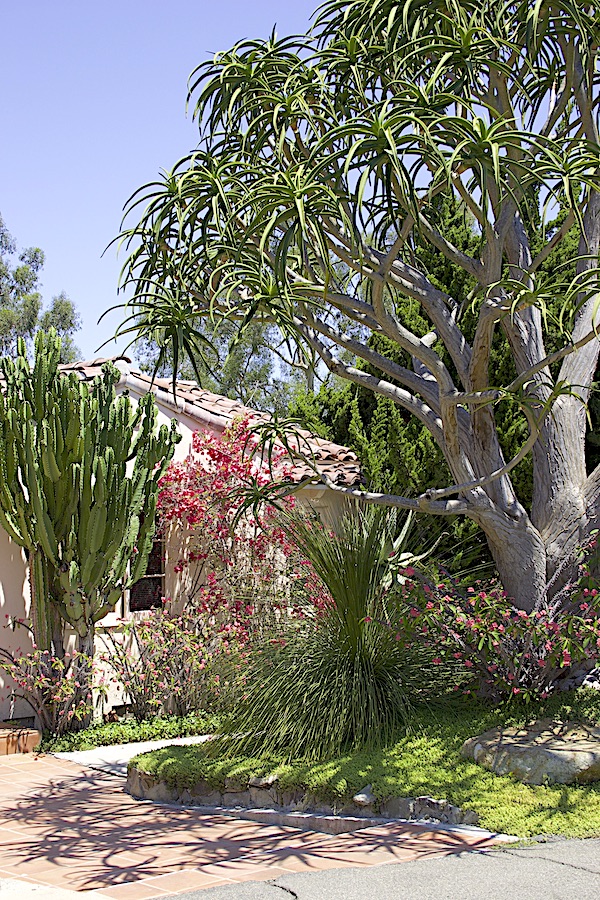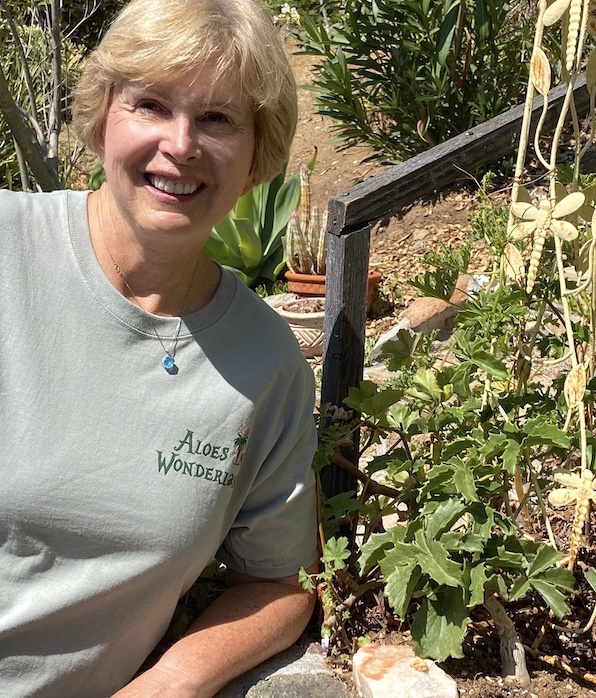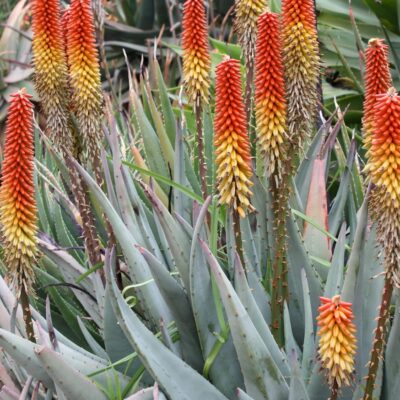If you have room in your garden and your climate is mild with a maritime influence, consider adding a tree aloe or two. Aloe barberae (aka Aloe bainesii, Aloidendron barberae), Africa's largest aloe, is sculptural, intriguing and dramatic. It's also a great source of the partial shade so desirable for soft-leaved succulents.

A tree aloe's leaf clusters cast starburst shadows.
Nurseries may sell rooted, boxed specimens for thousands of dollars, but like most succulents, tree aloes will start from cuttings---even large cuttings several feet long and branched.
DLB in wonderland
At Aloes in Wonderland---horticulturist Jeff Chemnick's home nursery in Santa Barbara---I descended into a forest of mature aloe trees. It was a surreal experience: South Africa in Southern CA.

In the aloe forest. Just out of view: the Cheshire Cat.
After the Fire
Jeff explained that when a wildfire destroyed his previous home in 2008, it also damaged a large Aloe barberae. When he removed the tree to make way for new construction, he salvaged its intact limbs. "I dug holes and stuck them in the ground," he recalls. "Like post holes, as if you were building a fence."
Jeff admits it was an experiment. He had no idea what would happen. "The rains came, and the cuttings rooted and started to grow," he says. He discovered that under optimal conditions, in-ground tree aloes grow up to two feet per year!
Success Tips
Here's what Jeff advises for Aloe barberae and similar Aloe 'Hercules' (a thicker-leaved x Aloe dichotoma hybrid):
Sun
Tree aloes need plenty of sun, ideally on a slope that's not north-facing (too shady).
Space
Give lots of room. Trunks and bases get massive over time, so don't plant close to buildings, pipes or pools. Avoid crowding a young tree aloe with more vigorous shrubs that might smother it.
Good Soil
Plant in fast-draining, loamy, sandy soil. The ideal pH is neutral or slightly acidic. Aloe trees like compost, too.
Water
Don't irrigate during cold, wet months. For optimal growth and flowering, water sparingly (once a month) up to weekly during hot, dry spells.
Cold protection
Cover when frost is predicted, especially when trees are young.
Fertilizer
In summer, apply a cactus-and-succulent fertilizer high in nitrogen, ideally with trace elements and micronutrients.
Tree aloe propagation
"Truncheons"---limbs with branches and leaf clusters---nearly always root, and having a small tree from the get-go is well worth a try.
Although some people prefer to let cuttings or truncheons dry several weeks, then root them in coarse sand (such as decomposed granite), Jeff plants them immediately. "They might take a few months to root and the leaves will fade somewhat," he says, "but once the leaves turn green again, you’re off to the races!"
Visiting Aloes in Wonderland
Jeff's Aloes in Wonderland is a landscaped, multi-acre botanic garden in which every plant is for sale. Yes, earth-moving equipment is sometimes needed. And yes, he'll whack off a tree aloe limb for you.
In addition to aloes, Jeff specializes in cacti, euphorbias, agaves and other large succulents; bromeliads (notably dyckias and hechtias), and cycads (which resemble stiff-leaved, upright palms). He also leads plant-habitat expeditions to Mexico and beyond.

So, what did I bring home?
Above: My new vining Cyphostemma quinatum and---to make the Mad Hatter green---an Aloes in Wonderland T-shirt. Hey Jeff, maybe do a ball cap?
Related Info on this site
Aloes: Uses, Photos, IDs & Varieties
Aloes: How To Grow & Varieties All about aloes plus a photo gallery of aloes ID’d and in bloom See All Succulent Types Aeonium Agaves Aloes Cactus Crassula Echeveria Euphorbias Ice Plants Kalanchoe Portulacaria Senecio About Aloes There are dozens of species of Aloe, from tall trees to dwarf cultivars. Aloes typically have juicy, triangular leaves…
The post Why You Need Tree Aloes appeared first on Debra Lee Baldwin. Copyright © Debra Lee Baldwin.
from Debra Lee Baldwin https://ift.tt/3eDNjrR
via IFTTT


No hay comentarios:
Publicar un comentario